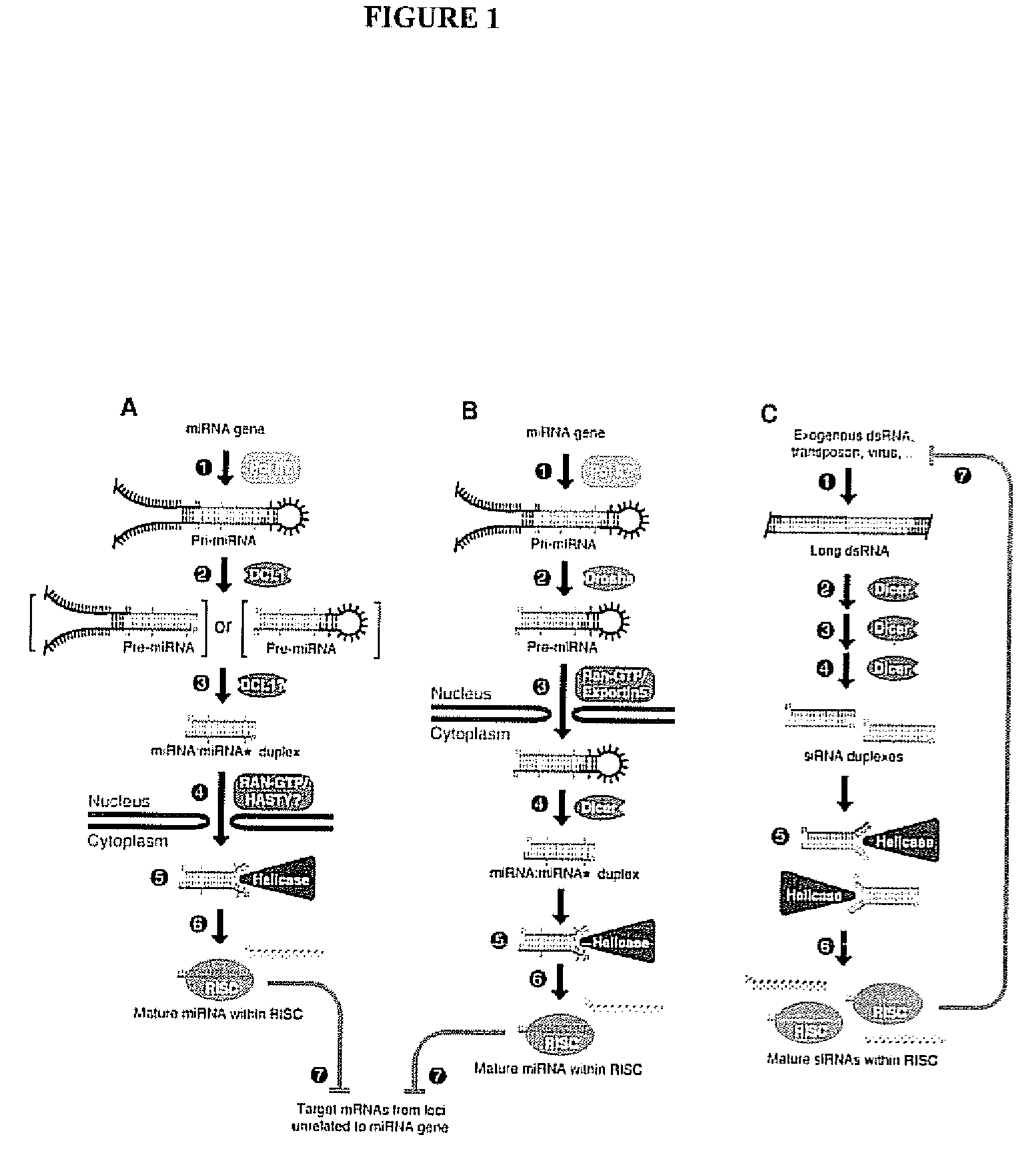Lung cancer-related nucleic acids
a technology of nucleic acids and lung cancer, applied in the field of microrna molecules, can solve the problems that the micrornas are difficult to identify using standard methodologies, and achieve the effect of specific hybridization and increased signal strength
- Summary
- Abstract
- Description
- Claims
- Application Information
AI Technical Summary
Benefits of technology
Problems solved by technology
Method used
Image
Examples
example 1
Prediction Of MiRNAs
[0122] We surveyed the entire human genome for potential miRNA coding genes using computational approaches similar to those described in U.S. Patent Application No. 60 / 522,459, Ser. Nos. 10 / 709,577 and 10 / 709,572, the contents of which are incorporated herein by reference, for predicting miRNAs. Briefly, non-protein coding regions of the entire human genome were scanned for hairpin structures. The predicted hairpins and potential miRNAs were scored by thermodynamic stability, as well as structural and contextual features. The algorithm was calibrated by using miRNAs in the Sanger Database which had been validated.
[0123] Table 1 lists the SEQ ID NO for each predicted hairpin (“HID”) from the computational screen. Table 1 also lists the genomic location for each hairpin (“Hairpin Location”). The format for the genomic location is a concatenation of . For example, 19+135460000 refers chromosome 19, +strand, start position 135460000. Chromosomes 23-25 refer to chro...
example 2
Prediction of Target Genes
[0129] The predicted miRNAs from the computational screen of Example 1 were then used to predict target genes and their binding sites using two computational approaches similar to those described in U.S. Patent Application No. 60 / 522,459, Ser. Nos. 10 / 709,577 and 10 / 709,572, the contents of which are incorporated herein by reference, for predicting miRNAs.
[0130] Table 4 lists the predicted target gene for each miRNA (MID) and its hairpin (HID) from the computational screen. The names of the target genes were taken from NCBI Reference Sequence release 16 (http: / / www.ncbi.nlm.nih.gov; Pruitt et al., Nucleic Acids Res, 33(1):D501-D504, 2005; Pruitt et al., Trends Genet., 16(1):44-47, 2000; and Tatusova et al., Bioinformatics, 15(7-8):536-43, 1999). Target genes were identified by having a perfect complementary match of a 7 nucleotide miRNA seed (positions 2-8) that have an “A” after the seed on the UTR and / or an exact match in the nucleotide before the seed ...
example 3
Differential Expression of miRNAs
1. Sequencing
[0136] To validate the hairpins (“HID”), a number of miRNAs were evaluated by sequencing methods similar to those described in U.S. Patent Application No. 60 / 522,459, Ser. Nos. 10 / 709,577 and 10 / 709,572, the contents of which are incorporated herein by reference. Table 3 shows the hairpins (“HID”) that were validated by sequencing a miRNA (“MID”) in the indicated tissue (“Tissue”). Numeric codes for the tissues are shown in Table 6.
[0137] To confirm the hairpins and miRNAs predicted in Example 1, we detected expression in various tissues (versus controls) using the high-throughput microarrays similar to those described in U.S. Patent Application No. 60 / 522,459, Ser. Nos. 10 / 709,577 and 10 / 709,572, the contents of which are incorporated herein by reference. Microarray images were analyzed using Feature Extraction Software (Version 7.1.1, Agilent).
[0138] Differential expression of the miRNAs was then analyz...
PUM
| Property | Measurement | Unit |
|---|---|---|
| Tm | aaaaa | aaaaa |
| temperature | aaaaa | aaaaa |
| temperature | aaaaa | aaaaa |
Abstract
Description
Claims
Application Information
 Login to View More
Login to View More - R&D
- Intellectual Property
- Life Sciences
- Materials
- Tech Scout
- Unparalleled Data Quality
- Higher Quality Content
- 60% Fewer Hallucinations
Browse by: Latest US Patents, China's latest patents, Technical Efficacy Thesaurus, Application Domain, Technology Topic, Popular Technical Reports.
© 2025 PatSnap. All rights reserved.Legal|Privacy policy|Modern Slavery Act Transparency Statement|Sitemap|About US| Contact US: help@patsnap.com

